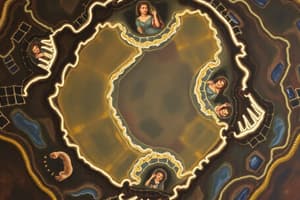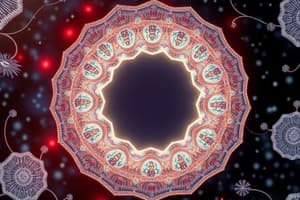Podcast
Questions and Answers
What is the primary function of the p53 protein in the cell cycle?
What is the primary function of the p53 protein in the cell cycle?
- To suppress tumor formation by controlling the cell cycle and repairing DNA. (correct)
- To regulate the production of cyclin-dependent kinases (CDKs).
- To promote rapid cell division during growth phases.
- To synthesize proteins required for DNA replication.
Which of the following events typically triggers the activation of p53?
Which of the following events typically triggers the activation of p53?
- Completion of DNA replication in the S phase.
- The successful completion of mitosis.
- An increase in the production of cyclin proteins.
- Detection of DNA damage or cellular stress. (correct)
What is the role of the Rb protein in regulating the cell cycle?
What is the role of the Rb protein in regulating the cell cycle?
- It promotes the progression of the cell cycle from the G1 to the S phase.
- It inhibits the activity of E2F transcription factors, preventing cell cycle progression. (correct)
- It activates cyclin-dependent kinases (CDKs) to initiate DNA replication.
- It triggers apoptosis in cells with damaged DNA.
Cyclin-dependent kinases (CDKs) are crucial for cell cycle regulation. What is their primary mechanism of action?
Cyclin-dependent kinases (CDKs) are crucial for cell cycle regulation. What is their primary mechanism of action?
What is the role of the G1/S checkpoint in the cell cycle?
What is the role of the G1/S checkpoint in the cell cycle?
During which phase of the cell cycle does DNA replication occur?
During which phase of the cell cycle does DNA replication occur?
What is the consequence of a mutation that inactivates the Rb protein?
What is the consequence of a mutation that inactivates the Rb protein?
Which of the following best describes the function of cyclin proteins in the cell cycle?
Which of the following best describes the function of cyclin proteins in the cell cycle?
What is the main purpose of the M checkpoint (spindle checkpoint) in mitosis?
What is the main purpose of the M checkpoint (spindle checkpoint) in mitosis?
Which of the following processes is inhibited by CKIs (CDK Inhibitors)?
Which of the following processes is inhibited by CKIs (CDK Inhibitors)?
What triggers a cell to enter the quiescent G0 phase?
What triggers a cell to enter the quiescent G0 phase?
How does the cell ensure that DNA replication occurs only once per cell cycle?
How does the cell ensure that DNA replication occurs only once per cell cycle?
What is the role of growth factors in the cell cycle?
What is the role of growth factors in the cell cycle?
How do extracellular matrix (ECM) signals influence cell behavior?
How do extracellular matrix (ECM) signals influence cell behavior?
What is the main difference between mitosis and meiosis?
What is the main difference between mitosis and meiosis?
Flashcards
Cell Cycle
Cell Cycle
The sequence of events a cell goes through from formation to division, including interphase and M phase.
Interphase
Interphase
Cell growth and preparation for division, including G1, S, and G2 phases.
M Phase
M Phase
Cell division phase, including mitosis.
G1 Phase
G1 Phase
Signup and view all the flashcards
S Phase
S Phase
Signup and view all the flashcards
G2 Phase
G2 Phase
Signup and view all the flashcards
p53 Gene
p53 Gene
Signup and view all the flashcards
Cell Cycle Arrest Pathway
Cell Cycle Arrest Pathway
Signup and view all the flashcards
Cyclin
Cyclin
Signup and view all the flashcards
CKI
CKI
Signup and view all the flashcards
G1/S Checkpoint
G1/S Checkpoint
Signup and view all the flashcards
S Checkpoint
S Checkpoint
Signup and view all the flashcards
G2 Checkpoint
G2 Checkpoint
Signup and view all the flashcards
M Checkpoint
M Checkpoint
Signup and view all the flashcards
Mitosis
Mitosis
Signup and view all the flashcards
Study Notes
- Cell cycle is the sequence of events a cell undergoes from formation to division into two daughter cells
- Cell cycle includes the interphase and M phase
- The cell cycle consists of four main phases
G1 Phase (Gap 1 - Preparation Phase)
- Cell increases in size
- Proteins and organelles needed for division are synthesized, and it also checks if environment supports DNA replication
- If conditions aren't right, the cell may enter a resting state of GO
S phase (Synthesis - DNA synthesis phase)
- DNA is copied to form two identical copies
- Chromosome duplication helps prepare for cell division
G2 Phase (Gap 2 - Cell Division Preparation Phase)
- DNA integrity checked after replication
- Proteins and enzymes that support cell division are synthesized
M Phase (Mitosis - Cell Division Phase)
- Cell divides to create two identical daughter cells
Gene p53 (genome guardian)
- p53 encodes protein p53, a transcription factor
- It controls the cell cycle, repairs DNA, and triggers apoptosis when a cell is irreparably damaged
- Tumour Suppressor genes include p53
- When DNA is damaged, p53 accumulates and activates target genes such as p21, which inhibits Cyclin-CDK, preventing the cell cycle from progressing from phase G1 to S
- p53 activates apoptosis genes such as BAX and PUMA if damage cannot be repaired
Mutations
- A TP53 mutation is one of the most frequent in cancers such as lung, breast, colorectal, and liver cancer
- Cells cannot stop the cycle or self-destruct in these loss-of-function mutations
Stress signals that activate p53
- Hypoxia
- UV radiation
- Ionizing radiation
- Chemotherapy
- TNF, FasL, TRAIL
- DNA Damage
Mechanism of activation and regulation of p53
ATM/ATR Kinase Pathway
- ATM and ATR kinases sense DNA damage
- They phosphorylate CHK1 and CHK2, activating p53 by preventing degradation by MDM2
MDM2 and MDM-X
- MDM2 inhibits p53 by binding and tagging it for degradation
- p14ARF prevents MDM2 from activating p53 in situations such as oncogene activation
Main pathways of p53 in cells
DNA Repair Pathway
-
Repair of DNA to maintain genomic stability is activated
-
P48, XPC participate in DNA repair to prevent mutation and genetic damage
Cell Cycle Arrest Pathway
- Cell cycle is paused at checkpoints to fix damage or eliminate damaged cells
- p21 inhibits the activity of the Cyclin-Cdk complex, preventing the transition from G1 to S or G2 to M
Apoptotic Pathway
- Programmed cell death is induced when damage cannot be repaired, preventing the accumulation of mutant or precancerous cells
- The protein include pro-apoptotic proteins like BAX and BAK, which activate programmed cell death
- Apoptosome is formed from Cyto c, Cas9, Cas3 leading to DNA fragmentation and cell death
Inhibition of Angiogenesis
- New blood vessel formation inhibited, reducing the ability of the tumor to grow and metastasize
- PAI, BAI1, TSP1, Maspin prevent the formation of new blood vessels, reducing the blood supply to the tumor
Gene RB (Retinoblastoma Protein)
- Tumour Suppressor genes include Gene RB
- RB controls the cell cycle progression by regulating the G1/S checkpoint
- It inhibits the E2F family of transcription factors, preventing cells from transitioning from G1 to S
How it works
- RB binds to and inactivates E2F in the unphosphorylated state, preventing the transcription of genes required for DNA replication
- When phosphorylated by the Cyclin D-CDK4/6 complex, RB releases E2F, allowing cells to enter S phase
Mutation
-
Loss-of-function mutations in RB result in unregulated E2F activity and stimulation of cell proliferation
-
RB1 mutations account for Retinoblastoma and involvement in many cancers such as lung and breast cancer
Cell cycle control molecules
- Cell cycle is tightly regulated by a series of regulatory proteins to ensure that cells divide at the right time and without errors
Cell cycle promoting protein groups
CDKs (Cyclin-Dependent Kinases)
- These are cyclin-dependent kinases which activate and promote cell cycle phase transition
- Cdk levels are relatively stable during stages of the cell cycle but are always inactive
Types of CDK
- Cdk4, Cdk2, Cdk1
Cyclin
- These are regulatory proteins, synthesized and degraded with each phase of the cell cycle, binding and activating CDK
- Cyclin levels fluctuate throughout the cell cycle, and are less abundant than Cdk
Types of Cyclin
- G1-cyclins (cyclin D)
- G1/S-cyclins (cyclin E)
- S-cyclins (cyclin A)
- M-cyclins (cyclin B).
- The variation in expression of cyclin at the phases are activated by internal and external information from cell relying upon the phase of cell cycle
How they interact with phases
- When a cell moves from one stage of the cell cycle to another where the checkpoint is exceeded a cytoplasmic enzyme destroys the acting cyclin
Types of cyclin-CDK and their role in cell cycle phases
- The G1 phase includes CDK4 and CDK6,Cyclin D these prepare the cell to pass into phase S
- The G1/S transition includes CDK2 and Cyclin E this begins the DNA replication process
- The S phase includes CDK2 and Cyclin A that maintain the DNA replication Process
- The G2/M transition includes CDK1 and Cyclin B, these promote the cells to move into mitosis
Groups of proteins that inhibit the cell cycle
CDK Inhibitors - CKIs
- CKIs are proteins that stop the cycle's cyclin-CDK activity in cell, they prevent it particularly for DNA in a damaged condition
- Main CKI groups are the the Cip/Kip (p21, p27, p57) group: Which control CDK2-cyclin E/A, as well as G1-S transition
- The INK4 group (p15, p16, p18, p19) inhibits CDK4/6-cyclin D and prevents G1 phase
How they work
- They directly connect with Cyclin/Cdk to prevents continuous action of the phases
- Post completion of a step CKI are ejected by the ubiquitin-proteasome path with the assistance of SCF(ubiquitin ligase) and F-box protein
p53
- Protein acts as the central control element, contributing considerably to DNA adjustment it activates apoptosis if its to intense
Rb (Retinoblastoma protein)
- Rb prevents transition from G1 to S. When in the presence of CDK4/6-cyclin D Rb losses its capacity to to stop E2F a factor that induces copying to replicate DNA
External Cell Signalling Factors
Growth factors
-
The promotion of division, growth and the difference in cells comes from growth factors, peptide in forms
-
The following processes go through transmembrane receptors activating internal signals
GPCR Pathway
- Protein G actives the enzymes that bind to GF causing the adenylate cyclase to increase increasing cAMP and activate PKA, Phospholipase C resulting in increases of DAG and IP3 leading to PKC and a release of CA2+
- This triggers inflammation , muscle movement and cellular multiplication
TKR route
- The GF connects to trigger receptor dimerisation.
- The system will initiate the production for protein include MAPK, PI3K/AKT, RAF and RAS
JAK/STAT Route
- They operate mostly from the factors that cause proliferation with connection to JAK cells that stimulate STAT movement within cell membrane stimulating transcription to initiate the genes
Signaling from extracelluar matrix
- Extracellular matrix (ECM) comprise all the molecular and supporting cell components comprising elastin , laminin , fibronectin as well as proteoglycan.
- ECM sends signal
How the mechanisms of ECM trigger signaling
Connection with integrins
- Cell receptors identify ECM components resulting the connection creating signals within the membrane
Stimulates several signals
- FAK, MAPK/ERK as well as PI3K/AKT are all the signals resulting from the combination of ECM that promotes the survival , transportation as well as multiplications
Impairs physical structure
- This alters the cell division also due to component of ECM
Subsistence factors
- They assist the cells to endure when under difficult settings stopping deaths of cells otherwise known as apoptosis
Characterises the following
Quench protein
- Includes such as Bax and Bark while energizing Bck-2, Bck -xL to energize cells
Allows for continuity
- In order to enable for continuation the cytochromes will have a limited leakage to activate the apoptosis process
Causes change in structure
-
This provides cells with continuous flow of energy so that cells can live for longer
-
How they work is by connecting to PI3K/Akt once its locked that it creates proteins that cause death this ensures cell function
Other factors which facilitate activity
Enhances aspects
- Cells tend to die away by enhancing and reducing such factor in proteins
Activating mTOR
- Promote additional growth and continue to promote cellular survival
Types cell signaling with growth factors
Stimulation of the IGF-1
- (Insulin stimulant ) this promotes rapid growth with nerve cell promotion
NGF stimulation
- (Nerve stimulant ) this keeps stable the survival and prevents death
Cytokine
- This triggers the distribution as well as diversity with protection towards auto immune responses , can be induced with IL-2 or the T cell receptors
Function of the factors
Hormone
- The regulation that hormone receptors provide the cells with helps the cells with division , growth and stimulation
The following will assist
Kích thích Estrogen
- Which builds the epithelial lining of the uterus for periods
The stimulation of T4
- Enhancing metabolism this helps assist with cellular division
Inhibitory cell
-
This enhances to protect cells from the risk of damage, enhancing growth and diversity
-
It does this with TGF-B slowing down division leading to the division of p15 and p21 assisting to stop in phase G1
Check points when errors in cell
- Cellular communication prevent the risk of errors from cells by keeping cells safe
G1/5 inspection
- Guarantees cellular division while assessing the size , environment and structural damage
DNA repair
- CycD-CDK4/6 triggering the RB for cell to prevent it if issues are found
Checks S
- Aims to make certain of correctness of of the duplication of protein within membrane, if DNA is found will continue to repair or destroy in the form of apoptosis (programmed cell destruction)
Checks G2 factors
- Makes Certain DNA is free of damage during transition in cell cycles while maintaining cells division
Checks M factor
- During metaphase to guarantee cells all go accordingly
During the factors that may take place
- Checks the division that the proteins can separate to complete mitosis
Cell multiplication
Mitosis
- The division of cells results in exact cellular copies due to genetic structure
Process involves
Multiplication
- Cell growing with body formation
The renewal of cell
- By fixing cellular division
Meiosis
- Division of of sex cells ensures diversity from genetic code
- Ensures genetics will continue through the various cell structures due to the unique characteristics
Studying That Suits You
Use AI to generate personalized quizzes and flashcards to suit your learning preferences.





